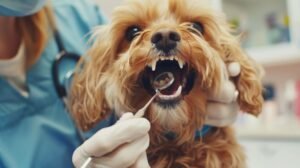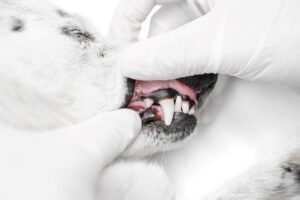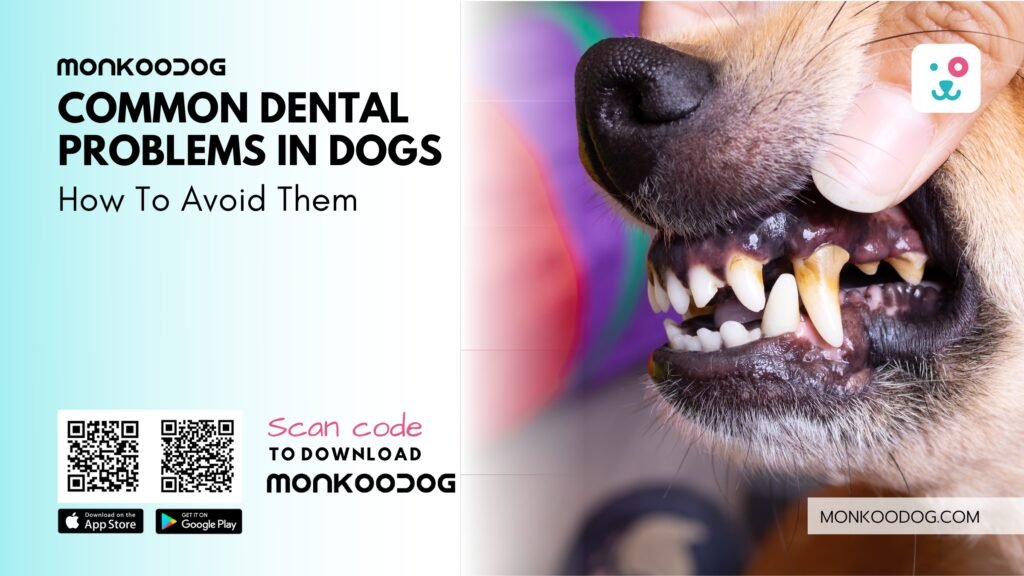Fido might greet you with enthusiastic tail wags and sloppy kisses, but have you ever noticed a less-than-pleasant odor emanating from his breath? Dental problems in dogs are incredibly common.
Once you ignore these issues, they can progress from bad breath to serious health complications. As a pet parent, understanding common dental problems and implementing a proactive prevention plan will help keep your furry friend’s smile sparkling and their breath fresh.
Below are some of the most prevalent dental issues in dogs:
Periodontal Disease
Periodontal disease, also known as gum disease, is the most prevalent dental problem in dogs. It’s a progressive bacterial infection that attacks the tissues surrounding the teeth, including the gums, ligaments, and jawbone. Periodontal disease also progresses through several stages:
- Gingivitis: This is the initial stage, characterized by inflammation of the gums. Gums may appear red, swollen, and bleed easily. Taking care of this issue at this stage can prevent further progression.
- Early Periodontal Disease: As the infection progresses, the ligaments and bone supporting the teeth begin to deteriorate.
- Advanced Periodontal Disease: In the later stages, significant bone loss occurs, leading to loose teeth and potential tooth loss.
Several signs and symptoms can indicate periodontal disease in your dog:
- Bad breath
- Red, swollen, or bleeding gums
- Difficulty chewing or eating
- Drooling excessively
- Pawing at the mouth
- Weight loss due to difficulty eating
- Loose teeth
Also read: Doggie Breath and What to do About It
Several factors contribute to periodontal disease in dogs. For example, a diet high in carbohydrates and sugars can promote plaque buildup, leading to gum disease. In addition, dogs lacking appropriate chew toys or those who chew on hard objects may be more prone to dental trauma and subsequent infection.
When left untreated, this condition can be quite painful for your pet and can even lead to tooth loss. That’s why regular dental care, including professional cleanings by a dog dentist, is so important for maintaining your furry friend’s oral health. Just like with human dentistry, veterinary dentistry offers cleanings, examinations, and treatment for periodontal disease in its various stages.

Dental Trauma
Dental trauma can occur when your dog chews on hard objects, falls, or encounters other accidents. The force of the impact can cause various injuries to the teeth and surrounding structures. Here are the different types of dental trauma a dog can experience:
- Fractured Teeth: This is the most common type of dental trauma. Fractures can involve the crown (visible portion) or the root of the tooth. The severity of the fracture will determine the treatment options.
- Chipped Teeth: Small pieces of the tooth enamel break off, usually due to chewing on hard objects. Minor chips may not require treatment, but larger chips can expose the dentin layer beneath the enamel, causing sensitivity and pain. In such cases, smoothing the chipped area or applying a dental sealant might be necessary.
- Tooth Dislocation: The tooth is loosened or displaced from its socket but remains attached. This is a dental emergency requiring prompt veterinary attention to reposition the tooth and potentially splint it for stabilization.
- Tooth Avulsion: Complete tooth loss from the socket. While sometimes a veterinarian can reimplant a recently avulsed tooth, extraction is often the recommended course of action.
Signs of dental trauma in dogs include:
- Bleeding from the mouth
- Difficulty eating or chewing
- Pawing at the mouth
- Drooling excessively
- Visible damage to the tooth (cracks, chips, discoloration)
- Loose teeth
By recognizing the signs of dental trauma, you can help your dog heal from injuries and maintain good oral health. Immediate veterinary care is crucial for any suspected dental trauma. Doing so can help save the tooth, prevent infection, and minimize pain for your dog.
The dental care treatment plan will depend on the type and severity of the trauma. Your veterinarian will perform a thorough examination, including X-rays if necessary, to determine the best course of action.
Gingivitis
Gingivitis is the initial stage of periodontal disease, characterized by inflammation of the gums. The gums appear red, swollen, and may bleed easily. While not a severe condition itself, gingivitis is a warning sign of potential future problems. Prompt detection and intervention at this stage are crucial to prevent progression to more advanced periodontal disease.
Look out for these signs of gingivitis: red and swollen gums, particularly around the base of the teeth. If you notice any signs of gingivitis, schedule a visit with your veterinarian for a dental cleaning and to discuss a dental hygiene routine for your dog.
- Malformed Teeth: Malformed teeth can occur in dogs due to various reasons, including genetics, developmental problems, or overcrowding in the jaw. Here are some of the most common types of malformed teeth and the challenges they can cause:
- Overcrowding: This occurs when there’s not enough space in the jaw for all the adult teeth to erupt properly. This can lead to teeth growing in at an angle, pushing against other teeth, or even becoming impacted (stuck under the gum line). Overcrowding can make it difficult for dogs to chew and clean their teeth effectively, increasing the risk of periodontal disease.
- Misaligned Teeth: Teeth that erupt at an abnormal angle can cause a variety of problems. Misaligned teeth can interfere with chewing, cause abnormal wear on other teeth, and irritate the gums or tongue.
- Missing Teeth: Some dogs may be missing one or more teeth due to developmental problems or trauma. Missing teeth can affect chewing ability and may cause surrounding teeth to shift out of place.
Malformed teeth in dogs can lead to issues with chewing, dental hygiene, and overall oral health. Addressing these problems immediately is crucial to prevent more serious health complications.
Other Dental Problems
While less common, other dental problems can affect dogs. These include:
- Oral Tumors: These can be benign or malignant and require veterinary diagnosis and treatment.
- Abscesses: These are painful pus-filled pockets that develop around the tooth root due to infection. They require veterinary treatment with antibiotics and potentially tooth extraction.
- Foreign Objects Lodged in Teeth: Chewing on sticks or other objects can sometimes lead to foreign objects getting stuck between or in teeth. This can cause pain and infection and needs to be removed by a veterinarian.
Although these dental problems are less common, they can cause significant discomfort and require timely veterinary care to ensure your dog’s health and well-being.
Strategies for Preventing Dental Problems
Preventing dental problems in dogs requires a proactive approach that includes maintaining good oral hygiene, providing a proper diet, and ensuring regular veterinary care. Here are some effective strategies to keep your dog’s teeth healthy:
Dental Hygiene Routine
Regular teeth brushing is the most effective way to remove plaque and tartar buildup from your dog’s teeth. Aim to brush your dog’s teeth at least 2-3 times per week, ideally daily. Start by introducing the process gradually, letting your dog get comfortable with the toothbrush and toothpaste.
Use a dog-specific toothpaste formulated for swallowing and a soft-bristled brush designed for dogs’ mouths. Focus on brushing the outer surfaces of the teeth at the gum line, where plaque accumulates most. While a full brushing is ideal, even a quick brush is better than none.
When choosing the right dog toothpaste, never use human toothpaste for your dog. Human toothpaste contains fluoride, which is toxic to dogs if swallowed. Dog toothpaste comes in various flavors like poultry or peanut butter to make the experience more palatable for your dog.
Alternative Dental Hygiene Options
If brushing proves difficult, alternative dental hygiene options can help. For instance, look for chews with a VOHC (Veterinary Oral Health Council) seal, indicating effectiveness in reducing plaque and tartar. These chews should be tough enough to scrape away plaque but soft enough to prevent damage to your dog’s teeth.
You can also use dental wipes can be used to wipe your dog’s teeth and gums daily, providing a quick and easy way to maintain oral hygiene, especially for dogs that dislike brushing. Other than dental wipes, invest in dental water additives, which you can add to your dog’s water bowl to help freshen breath and reduce plaque buildup.
While not as effective as brushing or chewing, they can be a beneficial addition to a dental hygiene routine. These alternatives offer convenient and effective options to maintain your dog’s oral health when brushing is not feasible.
Diet
A healthy diet is essential for maintaining dental health. Feeding your dog crunchy kibble can help clean their teeth naturally by reducing plaque buildup. Dental treats designed to promote oral health can also be beneficial. Avoid giving your dog sugary treats and human food, as these can contribute to dental problems. Additionally, consider incorporating the following into your dog’s diet for optimal dental health:
- Raw Bones: Raw bones can help scrape off plaque and provide natural chewing satisfaction. However, always consult your vet before introducing them to your dog’s diet to ensure they are appropriate and safe for your pet.
- Dental-Formulated Dog Food: Specially formulated dental diets are available that contain larger kibble or special coatings to reduce plaque and tartar. These foods can help maintain dental hygiene by promoting chewing and mechanical cleaning of the teeth.
- Fresh Vegetables: Carrots and other crunchy vegetables can serve as natural toothbrushes, promoting healthy gums and teeth. They are also a low-calorie, nutritious alternative to processed treats and can be safely incorporated into your dog’s diet.
Incorporating these dietary elements can contribute to your dog’s dental health, reducing the risk of dental problems and promoting overall well-being. A balanced diet tailored to your dog’s dental needs is a key component of effective dental care.
Chewing Habits
Providing safe and appropriate chew toys is important for maintaining dental health. Chewing helps reduce plaque and tartar buildup by mechanically cleaning the teeth. Avoid hard objects like bones, antlers, and hard plastic toys, as these can cause dental fractures and other injuries. Instead, opt for dental chews and rubber toys that are designed to be safe for chewing. These items are specifically formulated to be tough enough to clean teeth but gentle enough to prevent damage.
Also read: Top Six Healthy Ways Our Veterinary Doctors Take Care Of Our Pets
Regular Veterinary Checkups
Schedule regular veterinary checkups for your dog, including dental exams. Veterinarians can assess your dog’s oral health and identify any potential problems early on when they are easier and less expensive to treat. They can also provide guidance on a personalized dental hygiene routine for your dog.
By implementing these preventive strategies, it’s possible to reduce your dog’s risk of developing dental problems and ensure they maintain a healthy and happy smile for years to come.

Additional Considerations
In addition to general dental care practices, there are specific considerations for certain breeds and senior dogs. Understanding these unique needs can further enhance your dog’s dental health.
Dental Problems in Specific Breeds
Certain dog breeds can be more prone to dental issues due to their genetic makeup and physical characteristics. Small breeds, such as Dachshunds, Chihuahuas, and Yorkies, often have crowded teeth that are more susceptible to plaque buildup and periodontal disease.
Understanding the specific needs of your dog’s breed can help you tailor their dental care routine. Addressing breed-specific dental issues involves more frequent brushing, specialized dental products, and regular veterinary checkups to prevent severe problems.
Dental Care for Senior Dogs
As dogs age, their dental care needs change. Senior dogs are at a higher risk for dental problems due to years of plaque accumulation and potential underlying health issues. Continued dental care, including regular cleanings and monitoring, is essential to maintain their oral health and overall well-being.
Regular dental checkups for senior dogs can help detect issues early, and a tailored diet can support their changing dental health needs. Moreover, gentle brushing and softer dental chews may be more suitable for older dogs.
Conclusion
Maintaining your dog’s dental health is essential for their overall well-being. Neglecting dental care can lead to pain, tooth loss, and serious health complications. By implementing preventative strategies like regular teeth cleaning, a healthy diet, and proper chew toys, you can help reduce the risk of dental problems in your dog. So, make sure to prioritize your dog’s dental health and schedule a dental exam with your veterinarian today to ensure your furry friend has a healthy smile for years to come.

